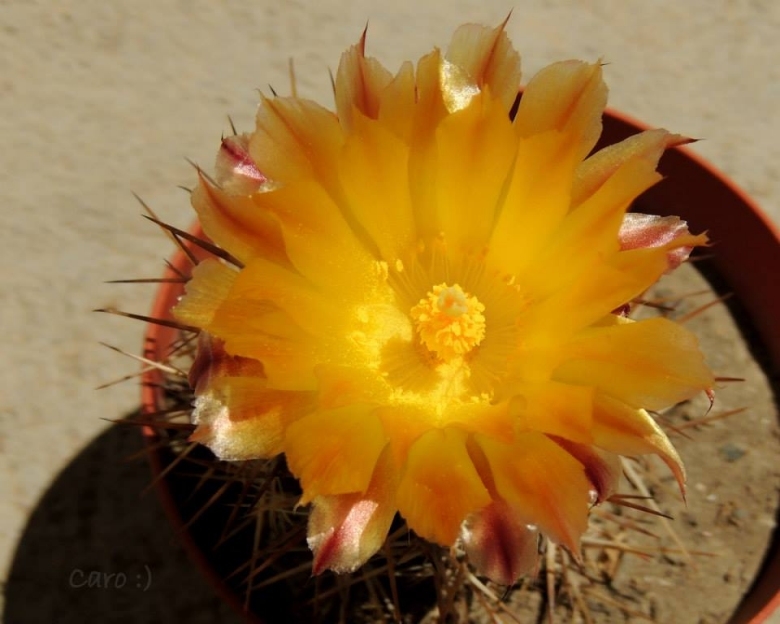
Austrocactus coxii Photo by: Carolina González
Origin and Habitat: Southern Argentina (Patagonia) and Southern Chile
Habitat: Grows on rocky soils, often among scrubs and grasses.
Synonyms:
See all synonyms of Austrocactus coxii
back
Accepted name in llifle Database:Austrocactus coxii (K.Schum.) Backeb.Cactaceae (Backeberg) 3: 1562. 1959Synonymy: 6
back
Description: Austrocactus coxiiSN|4004]]SN|4004]] is small winter-hardy cactus species with long stems covered by almost white spines. It is able to resist severe freeze.
Habit: It is a small solitary or clutered stem succulent, that branches at the base from a tuberous roots.
Stem: Dark green, always cylindrical that can lay sideways with time, 10 to 60 cm long, and 3-5 cm in diameter, when very old.
Ribs: Few (6 to 10) tuberculate.
Central spines: 1-4, whitish to light brown, robust, firm, up to 4 cm long, straight to curved at the ends, sometimes distinctly hooked.
Radial spines: 6-10 interwoven thinner and acicular up to 1 cm long.
Flowers: Diurnal, up to 3,5 cm long and in diameter, bell-shaped, often appearing near the top of the stem, mostly pale red, but ranging from yellowish-white to red.
Flowering: Usually occurs in the summer.
Fruit: Dry, green.
Bibliography: Major references and further lectures
1) Edward Anderson “The Cactus family” Timber Press, Incorporated, 2001
2) James Cullen, Sabina G. Knees, H. Suzanne Cubey "The European Garden Flora Flowering Plants: A Manual for the Identification of Plants Cultivated in Europe, Both Out-of-Doors and Under Glass" Cambridge University Press, 11/Aug/2011
3) David R Hunt; Nigel P Taylor; Graham Charles; International Cactaceae Systematics Group. "The New Cactus Lexicon" dh books, 2006
4) "Succulent Plant Research" Volume 1, David Hunt, Richmond 1994, page. 117.
5) John Borg “Cacti: a gardener's handbook for their identification and cultivation” Blandford P., 1970
6) Urs Eggli, Leonard E. Newton "Etymological Dictionary of Succulent Plant Names" Birkhäuser 2004 page. 55
7) Curt Backeberg “Die Cactaceae: Handbuch der Kakteenkunde.” Volume 3, 1959, page. 1562.
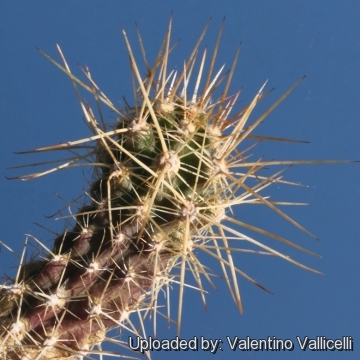 Austrocactus coxii Photo by: Valentino Vallicelli
Austrocactus coxii Photo by: Valentino Vallicelli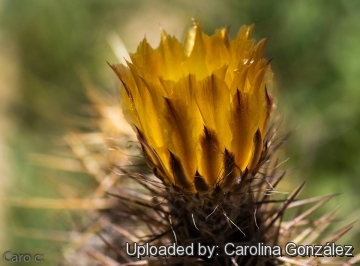 Austrocactus coxii Photo by: Carolina González
Austrocactus coxii Photo by: Carolina González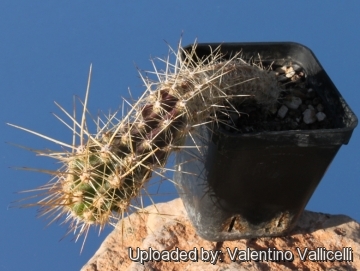 Austrocactus coxii Photo by: Valentino Vallicelli
Austrocactus coxii Photo by: Valentino Vallicelli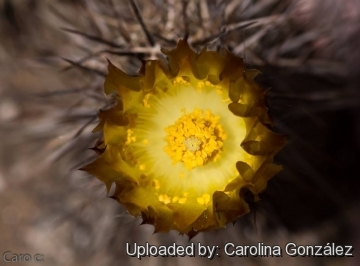 Austrocactus coxii Photo by: Carolina González
Austrocactus coxii Photo by: Carolina González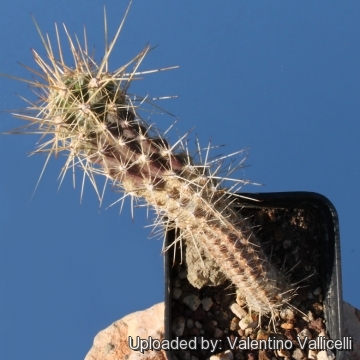 Austrocactus coxii Photo by: Valentino Vallicelli
Austrocactus coxii Photo by: Valentino VallicelliSend a photo of this plant.The gallery now contains thousands of pictures, however it is possible to do even more. We are, of course, seeking photos of species not yet shown in the gallery but not only that, we are also looking for better pictures than those already present.
Read More... Cultivation and Propagation: Austrocactus coxiiSN|4004]]SN|4004]] are relatively easy to grow, providing they are kept cold, but dry during autumn and winter. However difficult to find high quality plants of this species in cultivation. They are very cold hardy cacti theoretically hardy to -18°C (or more) particularly when dry. These cacti are often grown grafted. Plants cultivated outdoors are drought tolerant and take full sun. They are wonderful companion plant for Echinocereus and Escobaria cacti species and for Agave utahensisSN|581]]SN|581]].
Soil: It need a very well-drained, coarse mineral soil. To prevent rottenness it is also advisable to surround its root neck by very rough sand or grit, this help a fast water drainage and an appropriate air circulation.<br />
Repotting: Repot in the spring, when its roots become cramped. Generally, it should be repotted every other year in order to provide fresh soil. After repotting, do not water for a week or more.
Watering: It grows fairly fast in summer if provided with copious water but allows to dry thoroughly before watering again. During the winter quiescent period it must be strictly kept dry since it is very sensitive to any moisture excesses.
Fertilization: During the beautiful season it’s good to enrich the soil using a fertilizer rich in potassium and phosphorous, but poor in nitrogen, because this chemical element doesn’t help the development of succulent plants, making them too soft and full of water.
Exposition: It is essential to give full sun otherwise they will become atypical. If grown in full sun, the new growth will flower in spring and summer.
Frost Tolerance: Very frost hardy can withstand temperatures down to minus 18° C (or less). In cultivation overwinter in a cool place (at -5/-10°C) this is important for the flowers as well as for plants health. Without this cool winter period they normally wont get any buds.
Heat tolerance: In warmer climates it should be protected from excessive heat and too much sun sun in summer because it is not very heat tolerant.
Sun Exposure: Needs a full sun exposure (light shadow my be useful in the hottest summer days)
Reproduction: Suckers or seed. Remove the basal suckers (if available) in spring or summer and let the cuttings dry for a few days before inserting in compost. Sow the seeds in spring in a well-aerated compost at a temperatures of 22-24°C . Stand the pots in water, moisten thoroughly and drain. Scatter and press lightly the seed onto the top of the compost. But do not cover the small seeds with compost. Secure a polythene bag around the pot or cover the container with glass or and place in a warm shaded place. If possible, germinate in a propagator. Some seedlings may appear within a week or 10 days others will take longer. At lower temperatures, germination usually takes considerably longer. Once germination has taken place, remove gradually the glass or plastic and move into a good light but not in direct sun. If the young plants are exposed to too much sun, or the compost dries out, they may stop growing and often turn red; once they stop, it is often difficult to persuade them to start growing again. Never let the pots dry out-but don't saturate them either. A sodden compost is as harmful as a dry one. For its sensitive roots this species is frequently grafted to avoid root problems.















